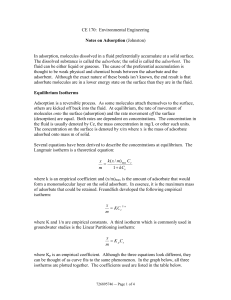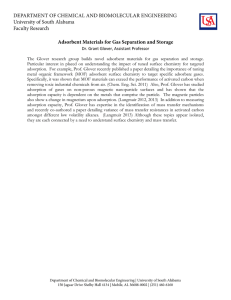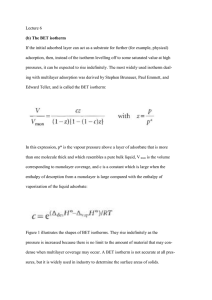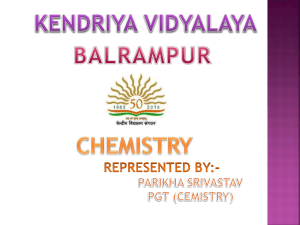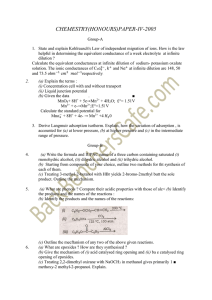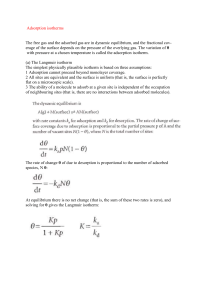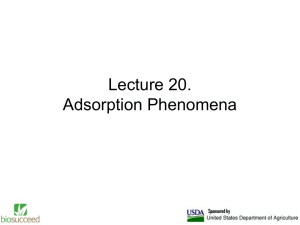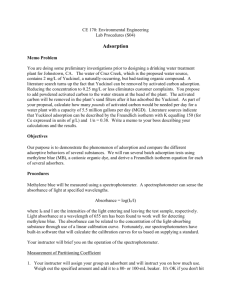ADSORPTION
advertisement
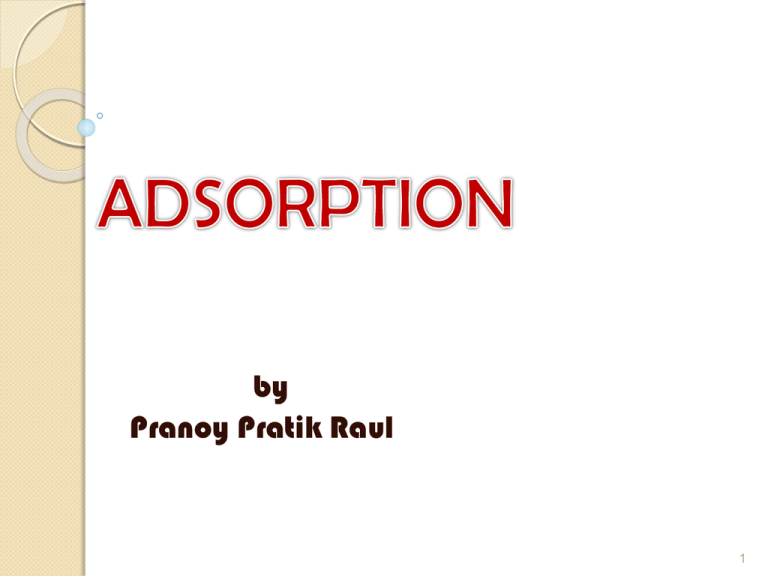
by Pranoy Pratik Raul 1 Content Definition Cause Classification Isotherms Applications Only 12 slides 2 What is Adsorption? Adsorption is a process that occurs when a gas or liquid solute accumulates on the surface of a solid or a liquid (adsorbent), forming a molecular or atomic film (adsorbate) ADSORBENT ADSORBATE SOLUTION 3 Absorption vs. Adsorption Bulk (Volume) Phenomenon Surface Phenomenon 4 Why does Adsorption occur ? Consequence of surface energy Atoms on the surface experience a bond deficiency, because they are not wholly surrounded by other atoms 5 Types of Adsorption WEAK, LONG RANGE Van der Waals interactions (e.g. London dispersion, dipole-dipole).. 5-50 kJ mol-1 Multi-layer No STRONG, SHORT RANGE Chemical bonding involving orbital overlap and charge transfer. Reversible Mostly Irreversible 40-800 kJ mol-1 Mono-layer Yes 6 Adsorption Isotherms Plot of the amount of adsorbate on the adsorbent as a function of its pressure (if gas) or concentration (if liquid) at constant temperature. Langmuir isotherm (adsorbed layer one molecule thick) Freundlich isotherm (Heterogeneous adsorbent surface with different adsorption sites) Brunauer, Emmett and Teller (BET) isotherm (molecules can be adsorbed more than one layer thick) 7 Freundlich Isotherm Freundlich and Küster (1909) Empirical formula: Limitation: Fails at high pressures Q- Mass of adsorbate / mass of adsorbent p- equilibrium pressure of adsorbate c- equilibrium con. Of adsorbate in solution K,n- constants 8 Langmuir Isotherm Irving Langmuir (1916) Assumptions: Uniformity of sites Common Mechanism Non interaction Monolayer only Semi-Empirical Formula: Q- Mass of adsorbate / mass of adsorbent Qmax- Maximum Q to form a mono-layer c- equilibrium con. of adsorbate in solution K - constant 9 BET Isotherm Stephen Brunauer, Paul Hugh Emmett and Edward Teller (1938) Assumptions: Multilayer Equal Energy No Transmigration Langmuir to each layer CS - saturation (solubility limit) concentration of the solute(mg/liter) KB - a parameter related to the binding intensity for all layers. 10 Applications Activated Carbon Hydrophobic Surface area-500m2/g Waste water treatment Decontaminant in pharmacy Silica Gel and Zeolites Hydrophilic Polar Drying of process air CO2 and Hydrocarbon removal from natural gas Vapor Adsorption Refrigeration Protein Adsorption on biomaterials(cells) 11 12
